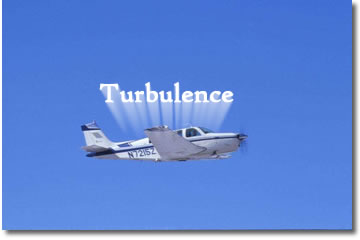 |
|
“Ignorance
is the curse of God; Air turbulence is something all pilots deal with from time to time. Pilots who choose to learn its causes, how it manifests itself and the types of situations, which produce it, are more likely to make positive decisions and take the necessary steps to ensure a safe and enjoyable flight. The type of flying a pilot engages in will certainly influence his or her decision-making process with regard to flying in turbulent air. A commercial pilot may well determine it is safe to fly in conditions that a private pilot flying for pleasure will dismiss as unnecessarily uncomfortable. As a flight instructor, most of my flying involves training, so decisions are based on the training environment presented by the current weather in relation to the particular student’s needs and level of skill and experience. All pilots, however, benefit from knowledge about and an appreciation of the reality of the conditions they will face on any given day. A well-grounded understanding of turbulence, its causes and its effects assists in good decision-making for any given flight. Turbulence is an irregular movement of air resulting from eddies and vertical currents. It is a very difficult weather event to predict and can vary from a mild irritation to a life-threatening situation. And, conditions can fool us, easily. How many times have we set off in what appeared to be nice, calm conditions only to find ourselves crashing and banging about at 3000’, thinking it might be more fun sitting back in the coffee shop telling lies? Turbulence is classed according to its severity as light, moderate, severe or extreme. Light turbulence is a very common occurrence, and is generally described as producing momentary, slight changes in altitude and/or attitude. Pilots and passengers may feel a slight tightening of their restraints; those prone to airsickness may want to find a horizon to keep focused on. In light turbulence, particularly in the summer when it’s hot, I’m particularly careful to keep an eye on beginning students with limited flight experience. In moderate turbulence, pilots and passengers will experience a definite tightening against their restraint systems. Loose objects in the cockpit may begin to move about, and airsickness can become a real likelihood. The transition from light to moderate turbulence is not a clear-cut point, but now the fun level is definitely decreasing rapidly. Pilots may well notice a silence descend over their passengers and would be well advised to keep checking on how those passengers are feeling. Flying is now becoming a bit of work rather than a relaxed afternoon checking out the scenery. Severe turbulence can produce considerable changes in attitude, altitude, heading and airspeed. We are definitely not having much fun, now. At moments, control of the aircraft may pass from the pilot to the weather; pilot and passengers will be thrown violently against their restraint systems. Any unsecured articles in the cockpit or baggage area will be on the move and may become quite dangerous to people and the aircraft itself. Extreme turbulence is a situation none of us want to experience first-hand. During extreme turbulence we can expect violent changes in the aircraft’s attitude, altitude, heading and airspeed. Control of the aircraft may become impossible; structural damage may occur. Conditions of extreme turbulence are certainly to be avoided by all general aviation pilots, no matter how bold, and by all but the very few, commercial and military pilots who specialise in this type of flying. Turbulence arises under four types of conditions or situations. Mechanical turbulence is produced when air passes over the ground, particularly irregular ground, and man made objects. As the moving air passes over objects, the airflow is disrupted and eddies and vertical movements are produced. The harder the wind blows the more disturbed air will become. Mechanical turbulence will, of course, diminish with altitude and with distance, both vertical and horizontal, from geographic features. I find it helpful to use the image of a river to understand mechanical turbulence. Air is a fluid, like water, and behaves in a very similar manner. Water flowing over an irregular streambed at high velocity will kick up quite a ruckus. As the fluid passes over and around obstacles, turbulence is created. The farther you are vertically or horizontally from an obstacle, the less you will be affected by the turbulence it produces. As the wind picks up, the experienced pilot will avoid, in particular, the downwind or leeward sides of hills and other barriers. He or she will learn to visualise the airflow around terrain features and anticipate where turbulence may be most likely expected. Moving air meeting an abrupt slope, for example, can be expected to produce turbulent up-drafts. An experienced pilot may well opt to use a higher altitude, particularly over uneven or irregular terrain, remembering, of course, that the velocity of the wind will tend to increase with altitude. Often, some experimentation with altitude will lead to increased comfort. In
mountainous areas, mechanical turbulence can become very significant.
Flying in mountains is a complex topic and any pilot contemplating this
type of flying is well advised to seek out an experienced person who can
provide a through checkout. Pilots with experience flying in the mountains
learn to be very alert as the wind increases. Thermal turbulence is, like mechanical turbulence, most severe at lower altitudes. Thermal turbulence is a common occurrence during the warmer months of summer and can result in some interesting experiences during landing and take off when we are operating aircraft in close proximity to the ground and at low airspeed. I still chuckle at myself remembering my first trip to the Sacramento Valley in California one summer. Trying to get the aircraft to touch down over tarmac heated to something like 60 to 70 degrees C was an interesting adventure! Frontal turbulence is produced along the interface of moving air masses. As warmer air is forced up and over cooler air, friction between the two air masses creates a zone of turbulence that can vary from light to severe or even extreme in the event of thunderstorm production. Frontal turbulence is most often associated with cold fronts, but can be produced by warm fronts, as well. A good weather briefing before any flight is an important part of preparation. Changing weather systems and moving fronts can present challenging flight conditions. A very high percentage of aircraft incidents and accidents list weather as a contributing factor, so knowledge of the expected meteorological conditions along a planned route of flight can greatly assist a pilot in decision-making regarding the route, altitudes and, indeed, whether a particular flight is safe to initiate. Wind shear, a shift in wind direction or velocity at altitude, can produce significant turbulence. At high altitudes clear air turbulence can result along the margins of the jet stream and can be a severe hazard to aircraft. At lower altitudes, where most of us spend our flying time, changing weather systems can often produce significant wind shear effects. These effects can be particularly dangerous during take-off and landing when we are operating low and slow. Unfortunately, wind shear is not easily observed or predicted, and, for the most part, we must rely on pilot reports. The poor fellow who has just experienced wind shear and reported it to FSS or ATC may be our only way of knowing that wind shear is a present hazard. The significant danger of wind shear is the abrupt change in wind speed and/or direction. Although the movement of the ambient air mass in which an aircraft operates does not affect the aircraft except in terms of ground speed, abrupt changes in that movement certainly can. Abrupt horizontal changes in wind speed can affect an aircraft’s airspeed. During landing and take-off when we are operating at a low airspeed an abrupt change of 15 to 20 knots can be critical. Vertical changes in wind can also produce potentially dangerous effects by changing our angle of attack and wing loading. A sudden gust from below can result in a stall by drastically increasing our aircraft’s angle of attack. A sudden gust from above can result in a stall by drastically increasing our aircraft’s wing loading. If a pilot is aware of potential wind shear, steps can be taken to reduce its danger. Increasing approach speed and increasing alertness to any changes in airspeed and attitude can be very helpful. Being prepared to take immediate corrective action is also useful. Of course, we would always choose to avoid situations with known, dangerous wind shear, for example the neighbourhood of thunderstorms. Turbulence is part of the reality of our weather systems and part of the reality of aviation. It is important for pilots to understand turbulence and to have a good grounding in its causes and affects. In 1901, Wilber Wright wrote, “If you are looking for perfect safety, you will do well to sit on a fence and watch the birds; but if you really wish to learn, you must mount a machine and become acquainted with its tricks by actual trial.” Knowing your aircraft, its systems and its limitations; knowing and having an honest appreciation of your own abilities and limitations as a pilot; making a study of weather and how it can effect the safety and comfort of flight; ensuring you have an up to date and current weather briefing before flight and developing positive decision-making patterns are all factors which help make flying a successful and enjoyable experience.
|



